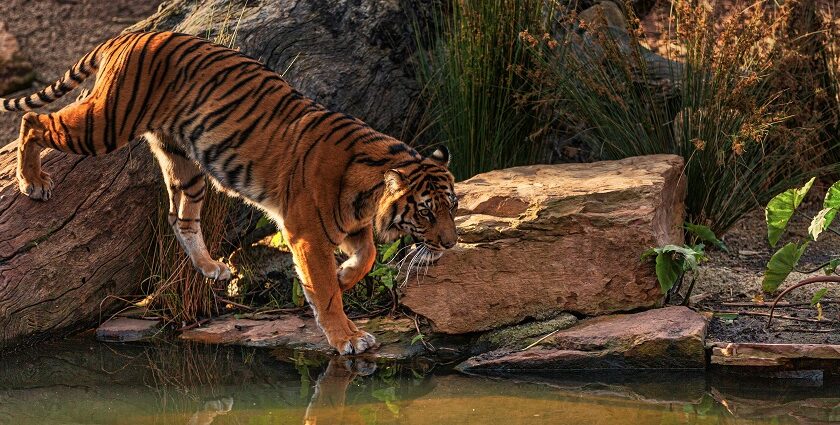I’ll never forget the moment our jeep rolled into Gorumara National Park, the air thick with the scent of sal trees and the distant trumpeting of an elephant. West Bengal’s jungles are a world apart, where Royal Bengal tigers prowl mangroves and rhinos graze under Himalayan shadows. With over 30% of the state’s land under forest cover, per the West Bengal Forest Department, its national parks and sanctuaries offer unforgettable safari experiences. From the mangrove labyrinths of Sundarbans to the misty trails of Neora Valley, this guide dives into the best jungle safaris in West Bengal, packed with practical tips and conservation insights to plan your adventure.
Why West Bengal for Jungle Safaris?
West Bengal’s diverse ecosystems, from Dooars grasslands to Himalayan foothills, host rare species like the one-horned rhino and Royal Bengal tiger. Its 12 national parks and sanctuaries, including UNESCO-listed Sundarbans, draw wildlife lovers globally. Safaris here blend adventure with cultural immersion, supporting local communities through eco-tourism.
A Biodiversity Hotspot
The state’s forests shelter 194 bird species, 27 fish species, and mammals like leopards and red pandas, per Gorumara National Park records. Each park offers unique flora and fauna, ensuring no two safaris feel the same. It’s a paradise for photographers and nature enthusiasts alike.
Cultural and Conservation Impact
Safari tourism funds conservation, with park fees supporting ranger patrols and habitat restoration. Local guides, often from indigenous communities, share stories of Bengal’s wild heart, making your trip both thrilling and meaningful.
- Key Species: Royal Bengal tiger, one-horned rhino, red panda, elephants.
- Ecosystems: Mangroves, grasslands, Himalayan forests.
- Conservation: Funds anti-poaching and community projects.
| Park/Sanctuary | Key Species | Unique Feature |
|---|---|---|
| Sundarbans | Royal Bengal tiger | Mangrove boat safaris |
| Jaldapara | One-horned rhino | Grassland jeep safaris |
| Gorumara | Indian elephant | Riverine forests |
Top Jungle Safari Destinations in West Bengal
West Bengal’s sanctuaries offer diverse experiences, from boat safaris in Sundarbans to jeep treks in Buxa. A 7–10-day trip, as suggested by TourRadar, covers multiple parks for a full wildlife adventure. Here’s where to go for the best sightings.
Sundarbans National Park
This UNESCO World Heritage Site, spanning 4,000 km², is the world’s largest mangrove forest. Home to 80–100 Royal Bengal tigers, it offers unique boat safaris through waterways teeming with saltwater crocodiles and Gangetic dolphins. November to March is ideal for spotting wildlife.
Jaldapara National Park
Located in Alipurduar, Jaldapara’s 217 km² hosts India’s second-largest one-horned rhino population. Jeep and elephant safaris reveal leopards, elephants, and 240 bird species. Its grasslands and affordability (₹100 entry) make it a must-visit from October to May.
Gorumara National Park
In the Dooars, Gorumara’s 79 km² is a haven for rhinos, elephants, and leopards. Jeep safaris along the Murti and Raidak rivers offer stunning views and sightings of 194 bird species. The park’s free entry and vibrant ecosystem draw families and solo travelers.
Buxa Tiger Reserve
Nestled in the Buxa Hills, this 759 km² reserve is home to tigers, clouded leopards, and hornbills. Its Himalayan setting and car safaris through dense forests make it a photographer’s dream. Visit from October to May for pleasant weather.
Neora Valley National Park
At 3,200 meters in Kalimpong, Neora Valley’s 88 km² shelters red pandas and Himalayan black bears. Its misty trails and colorful birdlife, like the scarlet minivet, are perfect for trekkers and birdwatchers. March to May offers clear skies for safaris.
Chilapata Forest
Near Jaldapara, Chilapata’s dense sal forests connect Buxa and Jaldapara, forming an elephant corridor. Jeep safaris to Mendabari watchtower reveal rhinos and 175 bird species. Its archaeological ruins, like Nalraja Garh, add historical intrigue.
Mahananda Wildlife Sanctuary
In Darjeeling’s foothills, Mahananda’s 159 km² hosts bison, leopards, and hornbills. Its proximity to Siliguri (8 km) and Bengal Safari Park makes it accessible for short trips. Birdwatching and jeep safaris shine from October to April.
Pros of Multi-Park Safaris:
- Diverse wildlife and ecosystems
- Supports conservation across regions
- Rich cultural experiences
Cons:
- Long travel times between parks
- Seasonal closures (monsoons)
- Higher costs for multi-destination tours
Best Time to Visit for Jungle Safaris
The dry season (October to May) is prime for safaris, with clear trails and active wildlife. November to March offers cool weather and peak sightings, especially for rhinos and tigers. Monsoons (June to September) close many parks due to flooding.
Seasonal Highlights
October to May provides pleasant weather, with March to April ideal for Chilapata’s rhino sightings. Sundarbans’ winter months (November–February) maximize tiger and crocodile encounters. Neora Valley’s spring (March–May) blooms with vibrant flora.
Weather Considerations
Summers (April–May) can hit 35°C in Dooars, but early morning safaris are comfortable. Winters (November–March) range from 10–25°C, perfect for all-day exploration. Avoid monsoons for safety and accessibility, per West Bengal Tourism.
Featured Snippet Opportunity: When is the best time for jungle safaris in West Bengal? The best time is October to May, with November to March offering cool weather and peak wildlife sightings. Avoid June to September due to monsoon closures.
Choosing the Right Safari Experience
West Bengal offers jeep, elephant, boat, and walking safaris, each suiting different preferences. Operators like Holy Tree Travel (4.9/5 on Tripadvisor) provide tailored packages, from 4-day Gorumara trips to 9-day Northeast tours. Choose based on budget and adventure level.
Jeep Safaris
Jeep safaris, like those in Jaldapara (₹2,500/vehicle), offer flexibility and cover large areas. They’re ideal for families and photographers, with guides spotting rhinos and leopards. Book through Bengal Tourism for reliability.
Elephant Safaris
Jaldapara and Gorumara offer elephant safaris (₹1,200/person), providing intimate wildlife encounters. They’re eco-friendly but limited in slots, so book early via West Bengal Forest Department. Perfect for couples and small groups.
Boat Safaris
Sundarbans’ boat safaris (₹3,500–₹5,000) navigate mangrove channels, offering tiger and dolphin sightings. Operators like Sundarban Explorers ensure safety and eco-conscious tours. Ideal for unique aquatic adventures.
Walking and Trekking Safaris
Neora Valley and Mahananda offer guided treks (₹200–₹400) for birdwatchers and trekkers. Trails like Purbikhola in Darjeeling reveal scenic beauty and rare species, per Adequate Travel.
- Safari Types: Jeep, elephant, boat, walking.
- Operators: Holy Tree Travel, Sundarban Explorers, Bengal Tourism.
- Booking: Online via northbengalwildanimalspark.in or migratetourism.in.
| Safari Type | Cost (INR) | Best For | Duration |
|---|---|---|---|
| Jeep | 2,500–5,000 | Families, photographers | 1–2 hours |
| Elephant | 1,200/person | Couples, intimate views | 45–60 mins |
| Boat | 3,500–5,000 | Tiger/dolphin spotting | 2–4 hours |
Comparison: Jeep vs. Elephant Safaris
- Jeep: Covers more ground, group-friendly, budget option.
- Elephant: Closer encounters, eco-friendly, limited availability.
Where to Stay: Jungle Camps and Lodges
From eco-friendly mud cottages to luxury resorts, West Bengal’s accommodations enhance your safari. Sundarban Jungle Camp and Jaldapara Jungle Camp offer immersive stays, with costs ranging from ₹2,000–₹5,000 per night.
Sundarban Jungle Camp
On Bali Island, this eco-resort offers mud cottages (₹3,500/night) with modern amenities. Boat safaris and village walks immerse you in mangrove life, supporting local conservation. Ideal for families and eco-travelers.
Jaldapara Jungle Camp
Near Jaldapara, this camp (₹3,000–₹5,000/night) offers tents and cottages with elephant safari access. Its rustic charm and birdwatching tours suit adventurers and couples. Book via Bengal Tourism.
Gorumara Jungle Resort
In Gorumara’s heart, this resort (₹4,000–₹5,000/night) provides spacious rooms and dining with forest views. Jeep safaris and cultural shows make it family-friendly. Perfect for Dooars exploration.
Chilapata Jungle Camp
This camp near Jaldapara (₹2,500/night) offers wooden cottages and machans. Its proximity to the elephant corridor and tea garden tours make it a budget-friendly gem for nature lovers.
- Budget Options: Mahananda Wildlife Resort (₹2,000/night).
- Luxury Options: Singalila Jungle Lodge (₹6,000/night).
- Eco-Friendly: Sundarban Jungle Camp, Bishnupur Jungle Camp.
Activities to Enrich Your Safari Experience
Beyond safaris, activities like birdwatching, village walks, and cultural evenings deepen your connection to West Bengal’s wild side. Guided tours ensure ethical wildlife interactions, per Responsible Travel guidelines.
Birdwatching and Photography
Mahananda and Purbasthali sanctuaries host 175+ bird species, like the white-cheeked bulbul. Photography tours in Buxa, with Nikon Monarch binoculars, capture leopards and hornbills. Book with Wildartexpeditions for expert guides.
Village and Cultural Immersion
Sundarban’s village walks reveal local life, while Chilapata’s Rabha tribal experiences offer cultural depth. Evening dance performances at Bishnupur Jungle Camp showcase Bengal’s heritage, per Travel + Leisure.
Trekking and Adventure
Neora Valley’s treks to Rohini waterfalls and Mahananda’s lake hikes blend wildlife with scenic beauty. Purbikhola’s 1-day trek is perfect for bird lovers, offering serene views, per Adequate Travel.
- Must-Do: Birdwatching in Purbasthali, village walks in Sundarbans.
- Gear: Binoculars, sturdy shoes, sunscreen.
- Operators: Wildartexpeditions, Migrate Tourism Pvt Ltd.
Pros of Diverse Activities:
- Enhances wildlife and cultural experiences
- Supports local communities
- Appeals to varied interests
Cons:
- Additional costs for specialized tours
- Weather-dependent activities
- Physical demands of trekking
Planning Your Jungle Safari: Practical Tips
A well-planned safari maximizes sightings and comfort. Book through trusted operators like Migrate Tourism Pvt Ltd (4.8/5 reviews) for seamless logistics. Bagdogra Airport and New Jalpaiguri station are key entry points for most parks.
Best Tools for Planning
Use apps like eBird for birdwatching and northbengalwildanimalspark.in for online bookings. Tripadvisor reviews help choose operators like Sri Balaji Tours (4.9/5). Local guides enhance authenticity, per Bengal Tourism.
Travel Logistics
Fly to Bagdogra (150 km from Dooars) or take trains to Alipurduar (40 km from Chilapata). Rent cars for flexibility, as roads to parks like Chilapata are rugged. Pack lightweight clothing and insect repellent for comfort.
Safety and Health
Follow guide instructions to avoid wildlife conflicts. Malaria precautions are advised for Sundarbans. Book safaris early (2–3 months) for peak season slots, especially for elephant rides, per Veena World.
- Book Early: Secure slots via northbengalwildanimalspark.in.
- Pack: Binoculars, sunscreen, waterproof gear.
- Health: Anti-malaria pills, updated vaccinations.
Supporting Conservation Through Your Safari
Your safari supports West Bengal’s wildlife. Park fees fund anti-poaching patrols, while eco-lodges like Sundarban Jungle Camp employ locals and use sustainable practices. Donating to WWF or Bengal Tiger Conservation helps protect habitats.
Ethical Wildlife Viewing
Keep a safe distance from animals and avoid feeding, as advised by PERHILITAN. Choose operators like Sundarban Explorers, who prioritize low-impact tourism. Your choices reduce stress on wildlife.
Contributing to Conservation
Donate to WWF’s tiger programs or volunteer with local NGOs like Bengal Nature Trust. Buy FSC-certified products to support sustainable forestry, preserving habitats for future safaris.
- Choose Ethical Operators: Responsible Travel, Wildartexpeditions.
- Support NGOs: WWF, Bengal Tiger Conservation.
- Sustainable Practices: Avoid single-use plastics, respect park rules.
People Also Ask (PAA)
What wildlife can I see on West Bengal jungle safaris?
Expect Royal Bengal tigers in Sundarbans, one-horned rhinos in Jaldapara, and red pandas in Neora Valley. Gorumara and Mahananda host elephants, leopards, and 175+ bird species.
When is the best time for jungle safaris in West Bengal?
October to May is ideal, with November to March offering cool weather and peak sightings. Monsoons (June–September) close most parks due to flooding risks.
Where can I book a jungle safari in West Bengal?
Book through Bengal Tourism, Migrate Tourism Pvt Ltd, or northbengalwildanimalspark.in. Operators like Holy Tree Travel and Sundarban Explorers offer tailored packages.
What are the best accommodations for West Bengal safaris?
Sundarban Jungle Camp (₹3,500/night), Jaldapara Jungle Camp (₹3,000–₹5,000), and Gorumara Jungle Resort (₹4,000–₹5,000) offer immersive stays with safari access.
How can I support conservation during my safari?
Choose eco-friendly operators, donate to WWF or Bengal Tiger Conservation, and follow park guidelines. Avoid littering and support sustainable products to protect habitats.
FAQ Section
What are jungle safaris in West Bengal?
Jungle safaris in West Bengal involve guided tours through national parks like Sundarbans and Jaldapara, offering jeep, elephant, boat, or walking experiences to spot tigers, rhinos, and more.
Which is the best jungle safari in West Bengal?
Sundarbans is the most popular for its unique boat safaris and Royal Bengal tigers. Jaldapara and Gorumara are top for rhinos and elephants, per Tripadvisor reviews.
Are West Bengal safaris safe for families?
Yes, jeep safaris in Gorumara and Jaldapara are family-friendly, with trained guides ensuring safety. Avoid night treks for young children due to wildlife risks.
What should I pack for a West Bengal jungle safari?
Pack binoculars, sturdy shoes, sunscreen, insect repellent, and lightweight clothing. A camera with a zoom lens is ideal for capturing wildlife, per Naturetrek advice.
How do safaris support West Bengal’s wildlife?
Park fees fund anti-poaching and habitat restoration, while eco-lodges employ locals. Supporting NGOs like WWF ensures long-term conservation of tigers and rhinos.
Conclusion: Your Wild Bengal Adventure Awaits
West Bengal’s jungles are a call to adventure, where the roar of a tiger or the rustle of a rhino can make your heart skip a beat. I still smile thinking of my Gorumara jeep ride, spotting a rhino grazing by the Murti River—it felt like stepping into a nature documentary. Whether you choose Sundarbans’ mangroves or Neora Valley’s misty trails, your safari supports conservation and local communities. Book through trusted operators like Bengal Tourism or Migrate Tourism, pack your binoculars, and dive into Bengal’s wild heart. Let’s keep these forests thriving for generations.





